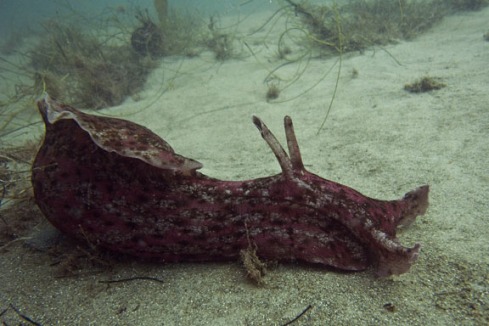You are currently browsing the tag archive for the ‘chemical’ tag.
Behold Aplysia californica–an extremely large sea slug which grazes on red algae along the California coast. The mollusk is rarely found at depths deeper than 20 meters. It grows to seventy-five cm (thirty inches) in length and weighs a whopping 7kg (15.4 lbs). Aplysia californica belongs to a family of sea slugs known as the sea hares –so called because the two rhinophores (smelling organs) atop the creatures’ heads are fancifully said to resemble a rabbit’s ears.
Although this Pacific gastropod is interesting in its own right, the slug is of greatest importance to humankind as a research animal (like the regenerating axolotl). Aplysia has only 20,000 neuron cells–as opposed to a human brain which contains between ten and a hundred billion–and the slug’s neurons are extremely large. This allows neuroscientists to easily observe and assess physiological and molecular changes which take place in the cells when the slug learns something. Aplysia research is thus at the cutting edge of neuroscience. Nearly everything we know about the molecular basis of memory and learning started out as research with the humble gastropod.
A news piece on CNN today featured Dr. Eric Kandel of Columbia University who won the 2000 Nobel Prize in Medicine & Physiology for neural research (mainly on these slugs) and made immense headway on what is probably the great cellular biology mystery of our time. It is a pleasure to see a science article on CNN online but it was also somewhat dismaying to see how many comments were basically “why are we wasting money on studying slugs?” In case it is not self-evident why we are trying to discover the fundamental molecular mechanisms of memory and cognition, here is a brief and not-at-all comprehensive list.
Understanding these underlying biological processes would probably help us find therapy for neuro-degenerative disorders (such as Parkinson’s disease, multiple sclerosis, and Alzheimer’s disease). It might also allow us to comprehend a number of psychiatric conditions, such as schizophrenia and depression. At some point in the future, understanding the molecular basis of memories and thoughts might also allow for the engineering of some sort of bioimplant for the nervous system. You could learn Sanscrit by popping a chip in your head or record your nightmares via wire! Beyond such science fiction concepts, knowing about how the brain works is an end into itself—understanding the most complicated known structure in the universe is a necessary step to building structures of greater complexity.
Although perhaps the politically polemicized commenters who object to studying the sea hare actually reject the creature’s sex life–which is indeed somewhat at odds with traditional notions of romance and propriety.
 Like all sea hares, Aplysia californica is a hermaphrodite with both male and female reproductive organs. Because of its physiology it can (and does!) use both sets of organs simultaneously during mating. Multiple Aplysia have been known to form chains of more than 20 animals (somewhat like pop beads) where each animal simultaneously acts as a male and female at the same time with its fore and aft partners. Copulation lasts for many hours (or sometimes for days). One can see how the creatures’ amorous predilections might not sit well with puritans and fundamentalists, however for providing a window into molecular neurophysiology we owe this gentle sea slug a big round of thanks.
Like all sea hares, Aplysia californica is a hermaphrodite with both male and female reproductive organs. Because of its physiology it can (and does!) use both sets of organs simultaneously during mating. Multiple Aplysia have been known to form chains of more than 20 animals (somewhat like pop beads) where each animal simultaneously acts as a male and female at the same time with its fore and aft partners. Copulation lasts for many hours (or sometimes for days). One can see how the creatures’ amorous predilections might not sit well with puritans and fundamentalists, however for providing a window into molecular neurophysiology we owe this gentle sea slug a big round of thanks.





